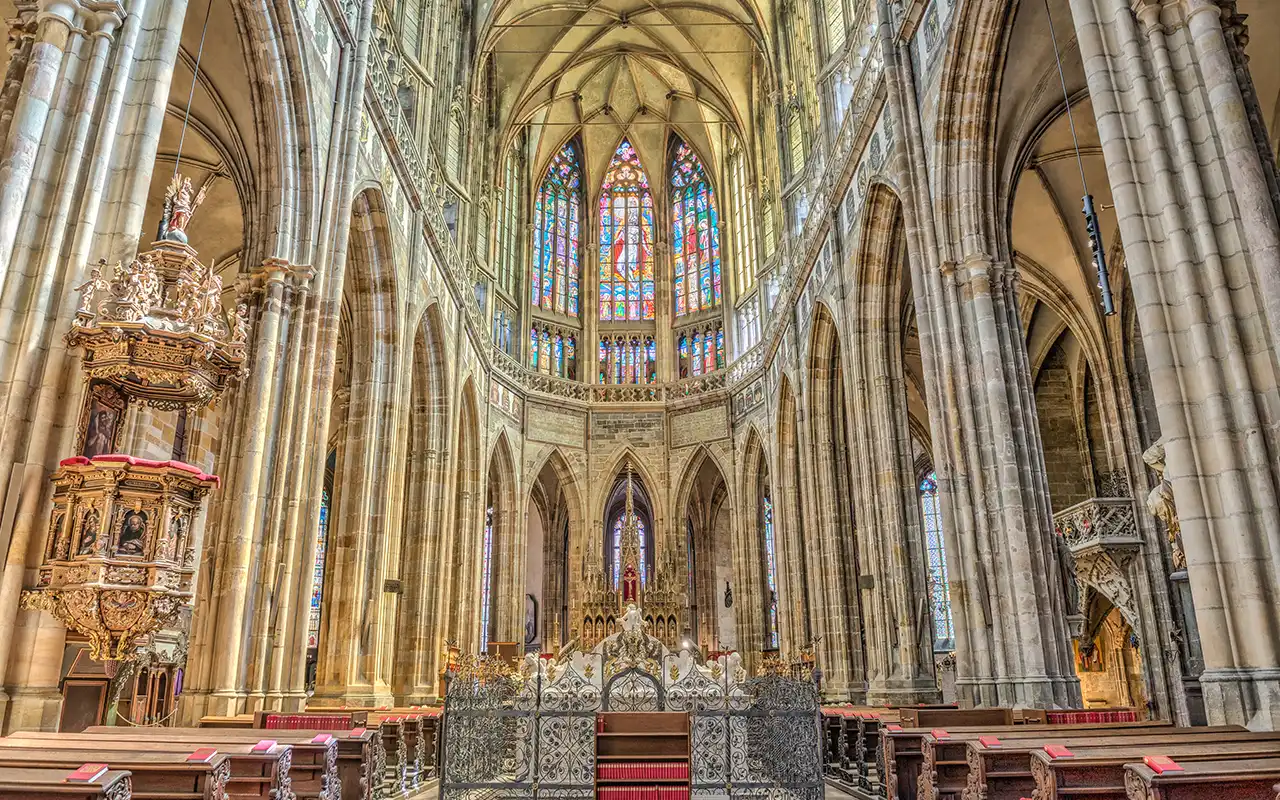
Navigating St. Vitus Cathedral : Answers to common questions
- Washrooms: Accessible restrooms are available within the castle grounds.
- Hours of Operation: Open daily, with hours varying by season and liturgical schedule.
- Important Information: Check the cathedral's schedule for special services, concerts, or events that may impact visitation.
- Admission Fee: Admission to the cathedral is free, though donations are welcome. Fees may apply for tower access or guided tours.
- How Long to Visit: Visitors typically spend 1-2 hours exploring the cathedral.
- Handicap Accessible: The cathedral is accessible, with entrances and paths accommodating visitors with disabilities.
- Pets: Service animals are permitted; other pets are not allowed inside the cathedral.
- Guided Tours: Guided tours are available, providing historical context and architectural insights.
- Restaurant or Cafe: No dining facilities inside the cathedral, but nearby areas within the castle grounds offer various options.
- Parking: Limited parking nearby; public transport or walking is recommended due to its location within Prague Castle.
- Family Friendly: Suitable for families, offering awe-inspiring architecture and stained glass windows to explore.
- Photography: Photography is allowed, but restrictions may apply during services or in certain areas.
- WIFI: WIFI access may be limited; check with the cathedral for specific availability.
- Gift Shop: The cathedral shop offers religious artifacts, books, and souvenirs.
Please note all times and prices subject to change. Please check the offical website for details.
More in our list of Things To Do In Prague
;Malá Strana Current Weather
Local Temp: 12.6℃ / 54.7℉
High: 14.2℃ / 57.6℉
Low: 10.9℃ / 51.6℉
Humidity: 87 %
Local Time: 12:58
Map for St. Vitus Cathedral
Did You Know?
The caThedral's full name is St. Vitus, St. Wenceslas and St. Adalbert CaThedral. These saints are very significant in The Czech cultural and religious history, with St. Wenceslas being The patron saint of Bohemia.
The construction of St. Vitus CaThedral began in 1344 but wasn't completed until 1929. Over These nearly six centuries, The caThedral has seen various architectural styles added to its design, reflecting The changing tastes and influences over The periods.
The caThedral houses The tombs of many Bohemian kings and Holy Roman Emperors, including Charles IV, under whose reign The construction of The caThedral began.
St. Vitus CaThedral is not only a prime example of Gothic architecture but also The largest and most important church in The Czech Republic. It's located within The Prague Castle complex and serves as The caThedral of The Archbishop of Prague.
The caThedral's Great South Tower houses The Zikmund, The largest bell in The Czech Republic. The bell, cast in 1549, is still used for special occasions but requires eight ringers to swing it.
Travel Information for
Prague Visitors
Time Zone: Prague operates on Central European Time (CET), which is 1 hour ahead of Greenwich Mean Time (GMT+1).
Weather: Prague experiences a continental climate with hot summers and cold winters. Summer temperatures average around 20°C (68°F), but can reach up to 30°C (86°F). Winters are cold, often dipping below 0°C (32°F), and snow is common. Spring and autumn are generally milder and are popular times to visit.
Population: Prague has a population of about 1.3 million people, making it the largest city in the Czech Republic.
Size: The city covers an area of approximately 496 square kilometers (191 square miles).
Language: The official language is Czech. English is widely spoken in tourist areas, but not as much in less touristy places.
Currency: The Czech Republic uses the Czech koruna (CZK). While some places accept Euros, it's more common to pay with korunas.
Safety: Prague is generally safe for tourists, but like any major city, it's advisable to take standard safety precautions, especially in crowded areas and when using public transportation.
Tipping: In restaurants, it's customary to leave a tip of around 10-15% if you're satisfied with the service. Tipping in bars is less common, but appreciated.
Electricity and Plugs: The Czech Republic uses Type C and Type E plugs, and the standard voltage is 230 V with a standard frequency of 50 Hz. Visitors from countries with different standards may need an adapter.
Water: Tap water in Prague is safe to drink and is of high quality.
Verified & Trusted Contact Information for St. Vitus Cathedral
Address:
Kostelní 1, 110 00 Praha 1, Czechia
Website: www.katedralasvatehovita.cz/en
Latitude: 50.0909
Longitude: 14.4005
More Places and Things To Do in Prague Within 500 km/300 mi of St. Vitus Cathedral
The Petřín Lookout Tower

The Distance from St. Vitus Cathedral to The Petřín Lookout Tower is 0.9 KM / 0.6 MI
The Astronomical Clock

The Distance from St. Vitus Cathedral to The Astronomical Clock is 1.5 KM / 0.9 MI
The National Theatre

The Distance from St. Vitus Cathedral to The National Theatre is 1.5 KM / 0.9 MI







